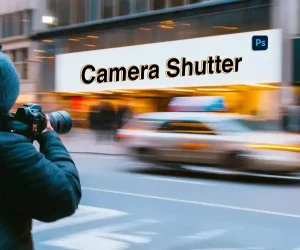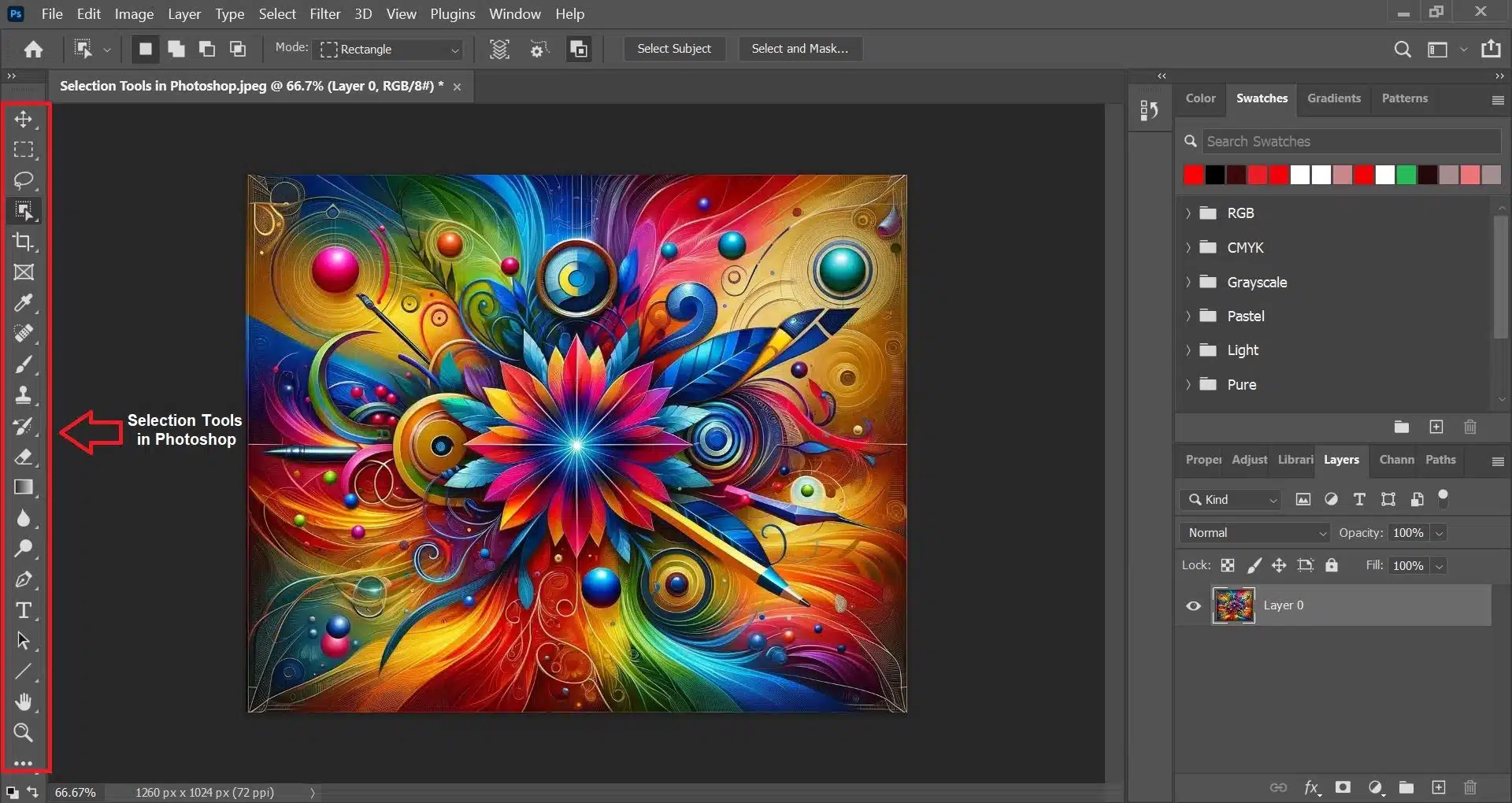
Introduction to Selection Tools in Photoshop
In this article, we’ll explore the various selection features available in Photoshop. We’ll provide step-by-step guides, practical tips, and examples to help you master each tool. From the versatile Quick Selection Tool to the precise Pen Tool, you’ll learn how to make the most of Photoshop’s powerful features. Whether you’re a beginner or looking to improve your skills, this Photoshop selecting Tools guide has everything you need.
Table of Contents
Overview of Common Selection Tools in Photoshop
Photoshop offers a variety of selection tools to help you work on specific parts of your images. These features allow you to isolate and manipulate different areas without affecting the entire image. Each tool has its own strengths and best uses. Understanding these tools can make your refining process smoother and more efficient. Below is a detailed table with various Photoshop selecting tools explained.
| Tool Name | Description | Best Use | Shortcut Key | Pros | Cons |
|---|---|---|---|---|---|
| Quick Selection | Selects areas based on color and texture. | Quick edits and adjustments. | W | Easy to use, fast, good for simple shapes. | Can be imprecise, may select unwanted areas. |
| Magic Wand | Selects pixels with similar colors. | Selecting large, solid areas. | W | Simple, great for high-contrast images. | Limited control, not good for complex shapes. |
| Lasso Tool | Freehand selection tool. | Rough selections. | L | Flexible, can draw any shape. | Difficult to control, not precise. |
| Polygonal Lasso | Creates selections with straight lines. | Geometric shapes. | L | Precise for straight edges, easy to use. | Not suitable for curved or irregular shapes. |
| Magnetic Lasso | Clings to edges of shapes as you draw. | Irregular shapes. | L | Automatically detects edges, good for detailed work. | Can be tricky with low-contrast edges. |
Other Common Selection Tools in Photoshop
There are some more common selection tools in Photoshop which strengths the power of Photoshop in a diversified manner.
| Tool Name | Description | Best Use | Shortcut Key | Pros | Cons |
|---|---|---|---|---|---|
| Pen | Creates precise paths that can be turned into selections. | Detailed and complex shapes. | P | Highly accurate, versatile for complex selections. | Steep learning curve, time-consuming. |
| Object Selection | Automatically detects and selects objects. | Complex objects. | W | Quick, uses AI to improve accuracy. | May need manual adjustments. |
| Select Subject | Uses AI to select the main subject in an image. | Quick subject isolation. | None | Fast, convenient for well-defined subjects. | AI can make errors, may miss parts of the subject. |
| Select and Mask Workspace | Refines edges and adjusts selections. | Perfecting selections. | None | Excellent for refining edges, multiple adjustment options. | Requires practice to master. |
| Color Range | Selects all instances of a specific color in an image. | Color-based selections. | None | Powerful for color-specific edits, good for consistent colors. | May select unintended areas, less useful for varied colors. |
| Focus Area | Selects areas in sharp focus. | Isolating focused subjects. | None | Ideal for depth-of-field effects, isolates subjects quickly. | Not effective with uniformly focused or blurred images. |
How to Use the Quick Selection Tool
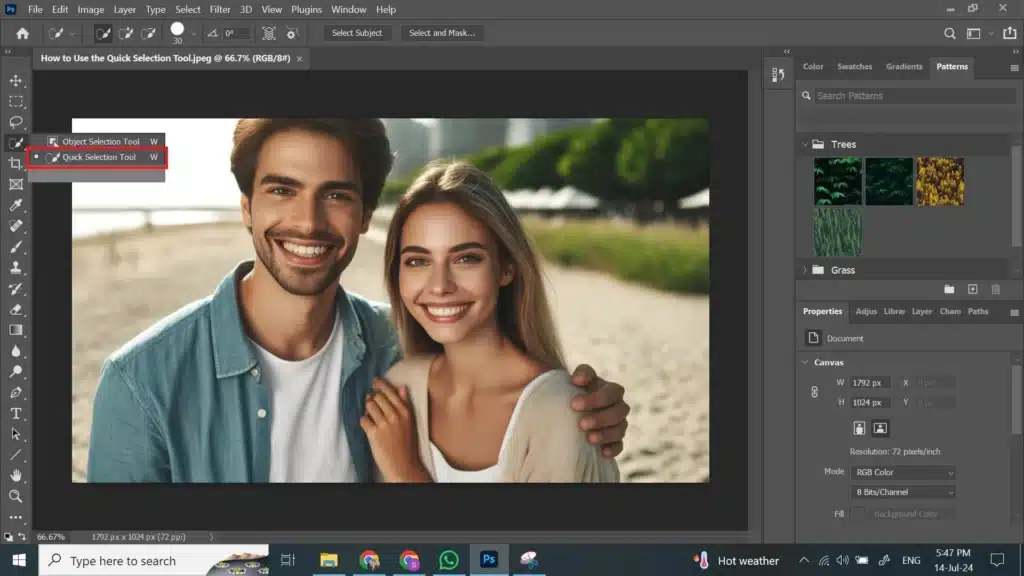
The Quick Selection Tool is one of the most popular selection tools in Photoshop. It helps you quickly choose parts of a picture to edit. This tool is very user-friendly and can save a lot of time. It works by finding similar textures and tones. This means you can select parts of an image with just a few clicks. In this section, we will explain how to use the Quick Selection Tool step-by-step. This guide will help you get the most out of your Photoshop selecting tools.
Getting Started
To start, open your image in Photoshop. Select the Quick Selection Tool from the tool panel. You can also press the W key as a shortcut. When you select this tool, your cursor can change to a circle with a plus sign inside. Next, click and drag the cursor over the part of the image you want to choose. Photoshop can automatically detect the similar textures and tones.
Adding to Your Selection
If the tool didn’t pick everything you need, you can add more. Hold down the Shift key on your keyboard. This changes the cursor to show a small plus sign. Now, click and drag over the new parts you want to include. Photoshop adds these new parts to your original choice.
Sometimes, you might need to modify the tool’s settings. At the top of the screen, you will see options for brush size and hardness. A larger brush can help you select bigger parts quickly. A smaller brush is better for detailed parts. Adjust these settings to fit your needs.
Removing Unwanted Parts
If the tool picks too much, you can remove parts you don’t want. Hold down the Alt key on your keyboard. This changes the cursor to show a small minus sign. Now, click and drag over the parts you want to remove.
You might need to zoom in to see better. Press Ctrl and the plus sign to zoom in. This can help you be more precise with your adjustments. Remember to switch back to adding mode by releasing the Alt key.
Practical Tips for Using the Quick Selection Tool
Here are some tips to help you use the Quick Selection Tool better. First, always start with a smaller brush size. This gives you more control. Second, use short, quick strokes instead of long drags. This helps the tool stay accurate.
Lastly, practice makes perfect. Spend time getting used to the tool’s behavior. Each image is different, so the tool might need different settings each time. The more you use it, the better you willunderstand how it works.
Mastering the Magic Wand Tool

The Magic Wand Tool is a powerful part of the selection tools in Photoshop. It helps you choose parts of a picture based on similar tones. This tool is great for picking large, solid regions, like a clear sky to be replaced. It’s part of the essential Photoshop selecting tools that every user should master. In this section, we’ll explain how to use the Magic Wand Tool.
Select the Magic Wand Tool
To begin, open your picture in the Adobe software. Then select the Magic Wand Tool from the left toolbar. Alternatively, you can press the W key on your keyboard. Your cursor changes to a wand icon.
Adjust Tolerance Settings
Look at the top of the screen for the Tolerance setting. Tolerance controls how similar the tones must be to be chosen. If you set the Tolerance to a low value, the tool picks only tones very close to the one you click. If you set it to a high value, it picks a wider range of tones. Start with a middle value, like 32, and modify as needed based on your results.
Click to Select
Click on the part of the picture you want to choose. The tool highlights the tones similar to where you clicked. You can see marching ants around the selected parts. If it picks too much or too little, modify the Tolerance setting and try again. Sometimes, it takes a few tries to get the perfect selection.
Add or Remove
To add more parts to your current choice, use the Shift key method (as explained above) or find the Add to Selection option (a square with a plus). Click on it, then add more parts by clicking on the picture.
To subtract parts, hold the Alt key or alternatively use the Subtract from Selection option (a square with a minus). Click on it, then remove parts by clicking on the picture.
Use Contiguous Option
The Contiguous option lets you choose only connected tones. Check this box if you want to select only connected parts. Uncheck it to select similar tones across the entire picture. This option is useful when you want to pick parts that are spread out but have similar tones.
Combine with Other Features
Utilizing the Lasso Tool and its Variants
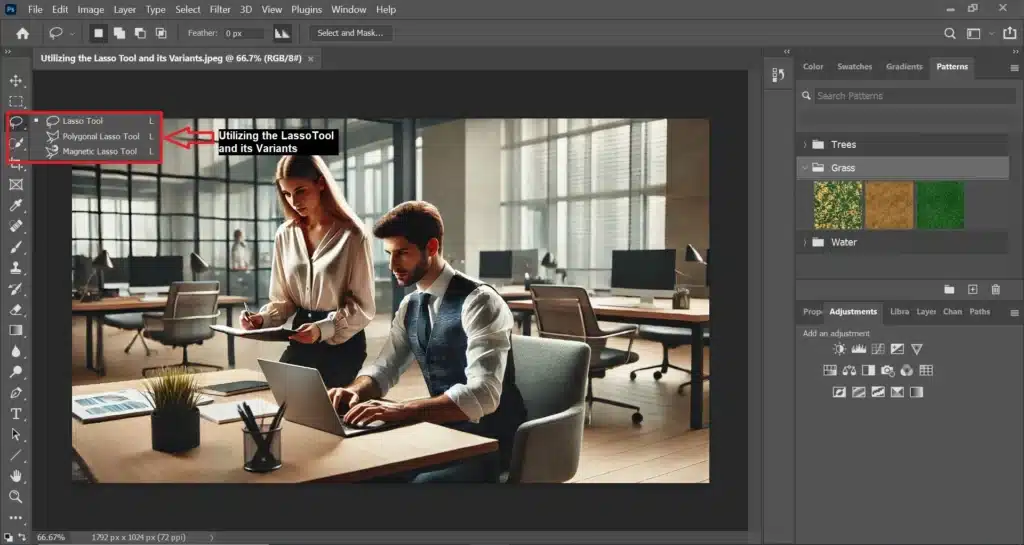
Among the versatile features in Adobe Photoshop, the Lasso Tool stands out for its flexibility. It allows you to draw freehand around the part you want to choose. This tool is great for rough, quick choices but can also be used for detailed work. There are three variants: the Lasso Tool, the Polygonal Lasso Tool, and the Magnetic Lasso Tool. Each has its own unique features and uses.
Using the Basic Lasso Tool
The basic Lasso Tool is perfect for freehand drawing. Upload your picture in the software and choose the Lasso Tool from the toolbar or by pressing the L key. Draw a line around the part you want to pick by holding down the mouse button. Once you complete the loop, the tool will create the selection.
Working with the Polygonal Lasso Tool
The Polygonal Lasso Tool is ideal for shapes with straight lines. Select this tool from the toolbar or by pressing the L key until it appears. Click on the starting point of your shape and continue clicking around the outline. Each click sets a straight line. When you reach the starting point, double-click to complete the shape. This tool is great for geometric objects or buildings.
Mastering the Magnetic Lasso Tool
The Magnetic Lasso Tool is perfect for choosing objects with well-defined boundaries. Select this tool from the tool panel or by pressing the L key until it appears. Click to start and then drag your cursor along the edge of the object. The tool sticks to the edges as you move. If it misses a spot, simply click to add a point. Double-click to finish. This tool is useful for selecting complex objects like people or animals.
Advanced Techniques with the Pen Tool
The Pen Tool allows you to draw very detailed and accurate paths around objects. These paths can then be turned into selections. While it has a learning curve, mastering the Pen Tool opens up a world of advanced editing possibilities. It’s a key part of the Photoshop selecting tools that professionals rely on.
Drawing Paths
To start using the Pen Tool, upload your picture in the Photoshop software. Choose the Pen Tool from the toolbar or by pressing the P key. Your cursor changes to a pen icon. Begin by tapping on the starting point of your path. Continue tapping to set anchor points around the object. Each point makes a straight line connecting to the next. To make curves, tap and hold to pull out direction handles.
Adjusting Anchor Points and Handles
Once you’ve placed your anchor points, you might need to modify them. Hold the Ctrl key and tap on any point to move it. This allows you to fine-tune your path. If you need to change the curve, hold the Alt key and shift the direction handles. This gives you full control over the shape of your path. Adjusting these points and handles helps you draw precise paths around complex shapes.
Converting Paths to Selections
After drawing your path, you can turn it into a selection. Right-tap on the path and choose “Make Selection.” A dialog box appears where you can set the feather radius. This controls how soft the border of your choice can be. Tap OK to create the selection. Your path is now ready to be edited, move, or mask.
Integrating with Other Tools
You can combine the Pen Tool with other features for even better results. For example, use the Quick Selection Tool to make a rough selection, then refine the border with the Pen Tool. This gives you the speed of the Quick Selection Tool with the precision of the Pen Tool.
Practical Tips for Using the Object Selection Tool
The Object Selection Tool offers advanced capabilities and is an important part of the selection tools in Photoshop. It allows you to pick and remove objects quickly and accurately by detecting their boundaries. This tool uses smart technology to make your post-processing faster and easier. Here are a few Photoshop selecting tools and tips for using this creative feature.
How to Use
Start by picking the Object Selection Tool from the tool menu bar or by tapping the W key until it appears. Your cursor changes to a selection icon. Hover over the object you want to pick. You can see a blue outline around the object, showing what the tool selects. Tap once to confirm your choice. If the tool doesn’t pick the object perfectly, don’t worry. You can refine it using any other tool.
Adjusting the Selection
Sometimes the Object Selection Tool might not pick everything you need. To fix this, hold the Shift key to add more to your current choice. Hover over the parts you want to include until they are outlined in blue, then tap to confirm. On the contrary, if it picks too much, hold the Alt key to subtract from your choice. Hover over the unwanted parts until they are outlined, then tap to remove them. This way, you can fine-tune your selection to be just right.
Examples of Using the Object Selection Tool
Imagine you have a picture of a busy street with many cars. You want to pick one car to change its color. Use the Object Selection Tool to hover over the car until it is outlined in blue. Tap to confirm your choice. If the tool misses parts of the car, hold Shift to include them. If it picks parts of the background, hold Alt to exclude them. This way, you can isolate the car.
Another example is a picture of a group of people. You want to pick one person to apply a filter. Use the Object Selection Tool to outline the person. Tap to confirm. Modify the choice as needed using Shift and Alt. This helps you focus on the person without affecting the rest of the picture.
Making Precise Selections with Select and Mask
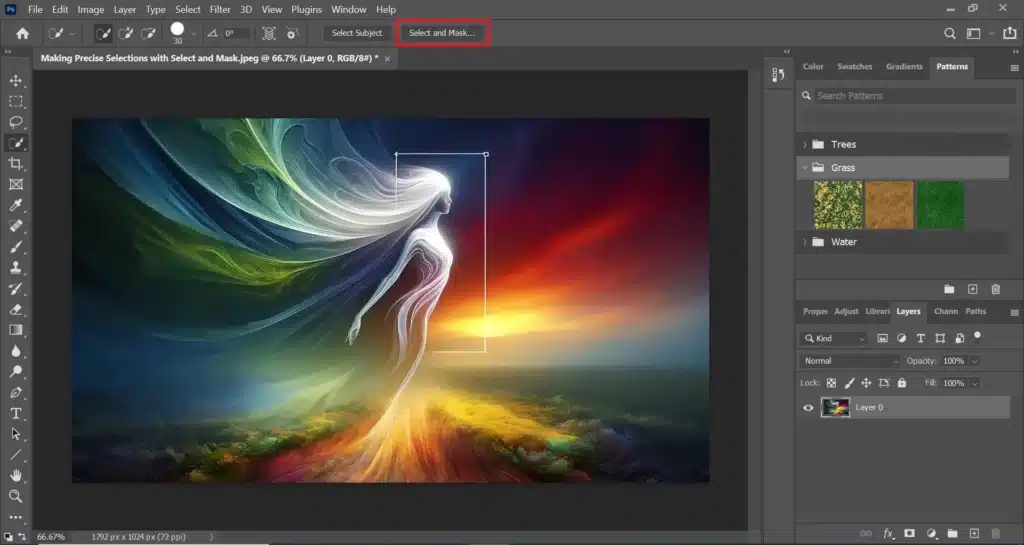
The Select and Mask Workspace is a powerful feature that helps you make precise choices. It is an essential part of the selection tools in Photoshop. This workspace allows you to refine your choices and make them look smooth and natural. It is perfect for detailed work, like selecting hair or soft edges. Try out these Photoshop selecting tools and methods with the select and mask feature.
Why Use it?
The Select and Mast is perfect for fine-tuning selections. When you need to make precise adjustments, this tool is your best friend. It helps blend the selected part seamlessly with the rest of the picture. For example, when you need to select strands of hair or the fluffy fur of an animal, it makes the job easy and accurate.
Accessing the Select and Mask Workspace
To start, choose your picture in the software and make an initial choice using any selection tool, like the Quick Selection Tool or the Lasso Tool. Once you have your initial choice, go to the top of the screen and find the “Select and Mask” button. Tap on it to open it. Your chosen area is now highlighted, and you can start refining it.
Refining Your Selection
In the Select and Mask Workspace, you can see several tools and sliders on the right side. Start with the “View” mode, which lets you see your selection against different backgrounds. This helps you see any mistakes. Use the “Transparency“ slider to modify how much of the original picture you see. This can help you make more accurate adjustments.
Next, use the “Edge Detection” section. The “Radius” slider helps you find soft or fuzzy parts. Modify it to include more or less of these parts. If you are working with fine details, like hair, this tool is very helpful.
Using the Global Refinements
The “Global Refinements” section has four main sliders: Smooth, Feather, Contrast, and Shift Edge. The “Smooth” slider helps to even out any rough parts of your choice. The “Feather” slider softens the border, making it look more natural. The “Contrast” slider makes the border sharper. The “Shift Edge” slider moves your border inward or outward to include more or less of the surrounding parts.
Examples of Using Select and Mask
Imagine you are editing a portrait and need to select the person’s hair. Start with a basic selection using the Quick Selection Tool. Click the Select and Mask Workspace. Use the Refine Edge Tool to carefully go over the hair. Adjust the Edge Detection and Global Refinements until the hair looks natural.
Another example is selecting a tree with lots of leaves. Use the Lasso Tool for an initial rough selection. Open the Select and Mask Workspace and refine the choice. Use the Radius slider to capture the soft, leafy edges. Adjust the Feather and Contrast sliders to make the border look realistic.
Understanding the Select Subject Tool
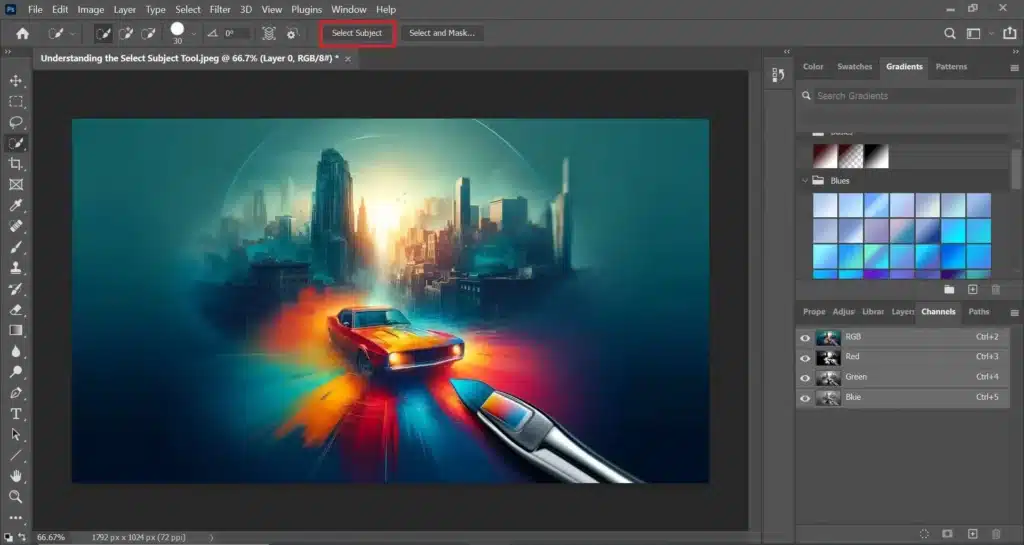
Imagine having a tool that instantly knows what you want to highlight in your picture. The Select Subject Tool in Adobe’s software does just that. It smartly identifies the main element, making it a standout feature among the selection tools in Photoshop. This tool is a game-changer, saving you precious time and making post-processing a breeze for both newbies and pros.
How It Works
The Select Subject Tool uses advanced algorithms to find the primary focus of your picture. To start, open your picture in Adobe’s software. Then choose any selection tool, like the Quick Selection Tool. At the top of the screen, you can see the “Select Subject” button. Tap on it, and the tool automatically identifies and highlights the main focus of your picture.
Fine-Tuning Your Selection
Sometimes, the tool might not get everything perfectly. You can easily fix this. Use the Lasso Tool or the Quick Selection Tool to modify the choice. Hold the Shift key to add more parts or the Alt key to take parts away. This way, you can make sure the tool has picked exactly what you need.
Tips for Using Select Subject
Zoom In for Accuracy
Use Ctrl and the plus sign to zoom in. This helps you see small details better. It makes your adjustments more precise. By zooming in, you can ensure that every tiny part is correctly chosen, making your edits cleaner and more professional.
Refine with Select and Mask
After using the Select Subject Tool, open the Select and Mask feature. This helps you refine your choice further. Use features like the Refine Edge Brush for detailed work. This feature allows you to smooth, feather, or shift the boundary, making your selection look natural and well-integrated with the rest of the picture.
Benefits of the Focus Area Selection Tool
The Focus Area Selection Tool in Adobe’s software is truly special. It helps you pick the sharp parts of a picture, making your editing faster and easier. This tool is perfect for photos where you want to isolate the main subject from a blurry background. By focusing on the sharp parts, you can create stunning effects and precise edits. Here’s a detailed table that shows the differences and benefits of this Photoshop selecting tool.
| Feature | Focus Area Selection Tool | Other Selection Tools |
|---|---|---|
| Purpose | Picks parts in sharp focus | Can be used for various purposes |
| Best Use | Ideal for portraits and detailed objects | Suitable for general editing tasks |
| Ease of Use | Simple to use with minimal adjustments | May require more manual adjustments |
| Accuracy | High accuracy in picking focused parts | Accuracy varies based on the tool |
| Speed | Fast and efficient for specific tasks | Speed depends on the complexity of the task |
| Refinement Options | Offers refinement features like Edge Detection | May require additional steps for refinement |
| Combining Tools | Can be combined with other tools like Select and Mask | Other utilities also need combining for best results |
| Automatic Detection | Uses advanced algorithms to find focused parts | Some features require more manual input |
| Learning Curve | Easy for beginners and effective for experts | Some utilities have a steeper learning curve |
| Application | Great for isolating subjects in focus and blurring the rest | Used for broader selection tasks across various parts |
Exploring the Potential of the Marquee Tool
The Marquee Tool is one of the simplest yet most powerful tools in Adobe’s software. It helps you choose rectangular and elliptical parts of a picture with ease. This tool is perfect for working with basic shapes and straight lines. It’s an essential tool in your Photoshop selecting tools toolkit. Whether you’re highlighting a section of text or isolating a round object, it makes the job easy and precise.
The Rectangular Marquee Tool
The Rectangular Marquee Tool helps you pick square or rectangular parts of your picture. To start, open your picture in Adobe’s software. Choose it from the menu bar. Your cursor changes to a crosshair. Drag it across the part you want to pick. When you release the mouse button, your chosen part is outlined.
Examples of Using the Marquee Tool
Imagine you are refining a picture and need to highlight a section of text. Use the Rectangular Marquee Tool to pick the text area. Feather the border slightly to make it blend smoothly. This technique is perfect for creating banners or highlighting important information.
Another example is isolating a round object like a moon in a night sky. Use the Elliptical Marquee Tool to outline the moon. Hold the Shift key to ensure a perfect circle. Feather the border to blend it with the dark sky. This method is ideal for creating stunning, focused highlights on round subjects.
Best Practices for Using Selection Tools in Photoshop
Mastering Photoshop selecting tools can make your editing tasks much easier. These utilities help you choose specific parts of a picture to edit or enhance. Using them correctly can save time and improve your results. Here are some best practices to help you get the most out of Photoshop selecting tools.
Start with the Right Selection Tools in Photoshop
Choosing the right tool for the job is crucial. If you need to pick a simple shape, like a square or circle, use the Marquee Tool. For freehand choices, use the Lasso Tool. If you need to pick parts based on similar textures, try the Quick Selection Tool. Using the right tool can make your work faster and more accurate.
Zoom In for Precision
Zooming in helps you see small details better. Use Ctrl and the plus sign to zoom in. This is especially helpful for detailed tasks, like picking out hair or tiny parts. The closer you look, the more accurate your choices will be. This makes your edits look more professional.
Refine Your Selection
After making an initial choice, use tools like Refine Edge or Select and Mask to fine-tune it. These tools help you smooth out rough parts and blend your choices seamlessly with the rest of the picture. They are great for making your work look natural and polished.
Practice Combining Selection Tools in Photoshop
Sometimes one tool is not enough. Combining different utilities can give you better control. For example, start with the Quick Selection Tool for a broad choice. Then use the Lasso Tool to refine the details. This method ensures you get the best of both worlds: speed and precision.
Save Your Selections
If you are working on a complex project, save your selections. Go to the Select menu and choose “Save Selection.” This allows you to load the selection later without having to redo it. Saving your work can save time and make your workflow more efficient.
Use Feathering for Soft Edges
Feathering helps to soften the border of your selection. This is useful when blending the chosen part with the rest of the picture. Use the Feather option at the top of the screen. Adjust the value to get the soft, gradual transition you need. This technique is great for creating natural-looking edits.
Example: Editing a Landscape Picture
Imagine you are editing a landscape picture with a bright sky and a dark foreground. Start by selecting the sky using the tool of your choice. Zoom in to ensure you have included all the fine details around the trees and mountains. Refine the edges to smooth out the selection and blend it with the horizon.
Next, adjust the sky’s brightness and contrast to make it more vibrant. Modify the shadows and highlights to bring out the details in the landscape. This method ensures that both the sky and the ground are edited precisely, creating a stunning, balanced photo.
Troubleshooting Common Issues using Selection Tools in Photoshop
Using selection tools in Photoshop can sometimes lead to problems. Understanding these issues and knowing how to fix them can make your editing process smoother. Whether you are using a Mac or Windows, these solutions will improve your refinement experience. Practice these troubleshooting methods to become more confident in your editing skills. Here is a table that highlights common issues with Photoshop selecting tools and how to solve them.
| Problem | Cause | Solution |
|---|---|---|
| Selection Too Rough | Low Feather setting | Increase Feather setting to soften the border |
| Missing Parts in Selection | Low Tolerance or incorrect tool usage | Modify Tolerance or use a different selection tool |
| Too Much Selected | High Tolerance setting | Lower Tolerance setting or refine the selection |
| Can’t Move Selection | Selection not active | Ensure the selection is active before moving |
| Slow Performance | Large file size or low system resources | Reduce file size or upgrade system resources |
| Tool Not Working Properly | Software glitch or incorrect settings | Restart software or reset tool settings |
| Issues with Fine Details | Low Resolution or improper tool use | Increase Resolution or use the Pen Tool |
| Selection Sticks to Unwanted Parts | Contiguous setting not enabled | Enable Contiguous setting for better control |
Frequently Asked Questions About Selection Tools in Photoshop
Understanding the selection tools in Photoshop can greatly enhance your editing skills. These features are the key to precise and efficient post-processing. To help you get the most out of these powerful utilities, we’ve compiled answers to some of the most frequently asked questions. Dive into these insights to unlock the full potential of Photoshop selecting tools and take your projects to the next level.
What are selection tools in Photoshop?
Selection tools in Photoshop help you choose specific parts of a picture. They let you edit, move, or change parts without affecting the whole photo. Examples include the Lasso Tool, Marquee Tool, and Quick Selection Tool. Each tool has a special use, like drawing freehand shapes or picking parts with similar textures. These utilities are essential for detailed post-processing tasks and are available on both Mac and Windows versions of Photoshop.
What is the shortcut key for the selection tool?
Every selection tool in Photoshop has a different shortcut key. For example, the Marquee Tool uses the M key. The Lasso Tool uses the L key. The Quick Selection Tool can be accessed by pressing the W key. These shortcuts make it faster to switch between tools and are the same for both Mac and Windows users.
What is the selection brush in Photoshop?
The selection brush, lets you paint over the part you want to pick. It finds similar textures and picks them as you paint. This tool is very useful for selecting detailed parts quickly and easily. It helps to refine your choices, especially in complex pictures.
What is the smart selection tool in Photoshop?
The smart selection tool refers to features like the Object Selection Tool and Select Subject Tool. These tools use advanced technology to identify and highlight the main parts of a picture. They save time by making accurate choices automatically. These features are great for both beginners and experts, helping you edit more efficiently. They work well on both Mac and Windows versions of Photoshop.
Conclusion of Selection Tools in Photoshop
Using the selection tools in Photoshop has transformed my editing skills. I remember editing a family photo where I wanted to brighten the faces without changing the background. By using the Quick Selection Tool to pick the faces and then refining it with the Refine Edge Tool, I achieved a natural and vibrant look. It made the whole picture come alive.
These Photoshop selecting tools are essential for anyone who wants to improve their editing. If you want to learn more and become a pro, check out our courses. We offer detailed lessons on using Photoshop and Lightroom. Visit Photoshop Course and Lightroom Course to start your journey today. Enhance your skills and create stunning edits with ease!
Have a nice photoshoot!
Learn more about Photo Editing with Lightroom and Photoshop:
Course
Light Effect Photoshop
Lightroom Course 2025
Adobe Photoshop Course 2025
Photo Editing Course
Get the latest version of Photoshop & Lightroom



